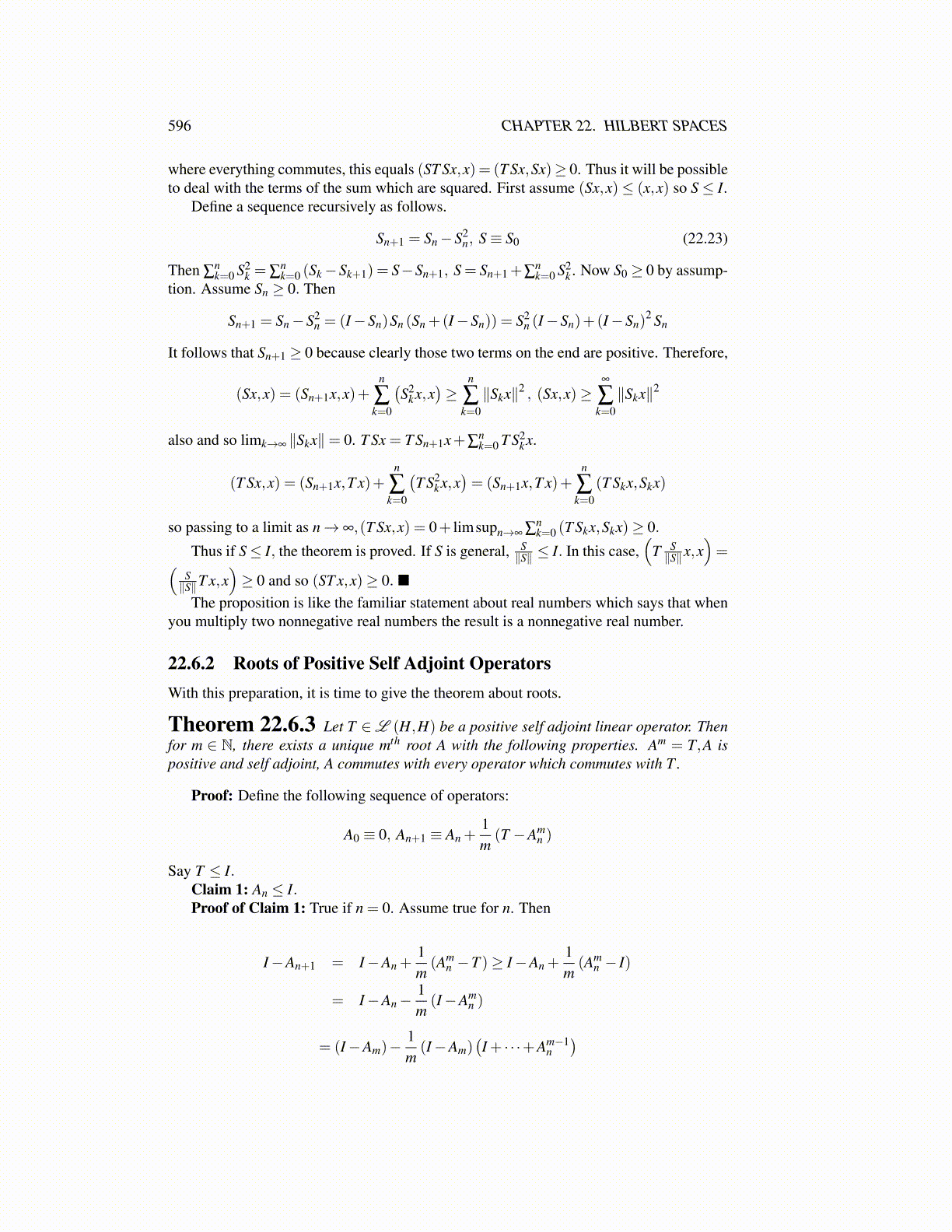
596 CHAPTER 22. HILBERT SPACES
where everything commutes, this equals (ST Sx,x) = (T Sx,Sx)≥ 0. Thus it will be possibleto deal with the terms of the sum which are squared. First assume (Sx,x)≤ (x,x) so S≤ I.
Define a sequence recursively as follows.
Sn+1 = Sn−S2n, S≡ S0 (22.23)
Then ∑nk=0 S2
k = ∑nk=0 (Sk−Sk+1) = S−Sn+1, S = Sn+1+∑
nk=0 S2
k . Now S0 ≥ 0 by assump-tion. Assume Sn ≥ 0. Then
Sn+1 = Sn−S2n = (I−Sn)Sn (Sn +(I−Sn)) = S2
n (I−Sn)+(I−Sn)2 Sn
It follows that Sn+1 ≥ 0 because clearly those two terms on the end are positive. Therefore,
(Sx,x) = (Sn+1x,x)+n
∑k=0
(S2
kx,x)≥
n
∑k=0∥Skx∥2 , (Sx,x)≥
∞
∑k=0∥Skx∥2
also and so limk→∞ ∥Skx∥= 0. T Sx = T Sn+1x+∑nk=0 T S2
kx.
(T Sx,x) = (Sn+1x,T x)+n
∑k=0
(T S2
kx,x)= (Sn+1x,T x)+
n
∑k=0
(T Skx,Skx)
so passing to a limit as n→ ∞,(T Sx,x) = 0+ limsupn→∞ ∑nk=0 (T Skx,Skx)≥ 0.
Thus if S≤ I, the theorem is proved. If S is general, S∥S∥ ≤ I. In this case,
(T S∥S∥x,x
)=(
S∥S∥T x,x
)≥ 0 and so (ST x,x)≥ 0. ■
The proposition is like the familiar statement about real numbers which says that whenyou multiply two nonnegative real numbers the result is a nonnegative real number.
22.6.2 Roots of Positive Self Adjoint OperatorsWith this preparation, it is time to give the theorem about roots.
Theorem 22.6.3 Let T ∈L (H,H) be a positive self adjoint linear operator. Thenfor m ∈ N, there exists a unique mth root A with the following properties. Am = T,A ispositive and self adjoint, A commutes with every operator which commutes with T .
Proof: Define the following sequence of operators:
A0 ≡ 0, An+1 ≡ An +1m(T −Am
n )
Say T ≤ I.Claim 1: An ≤ I.Proof of Claim 1: True if n = 0. Assume true for n. Then
I−An+1 = I−An +1m(Am
n −T )≥ I−An +1m(Am
n − I)
= I−An−1m(I−Am
n )
= (I−Am)−1m(I−Am)
(I + · · ·+Am−1
n)